Seagate and LaCie at CES 2015
by Ganesh T S on January 7, 2015 10:15 AM EST- Posted in
- CES 2015
- Storage
- Seagate
- LaCie
- Trade Shows
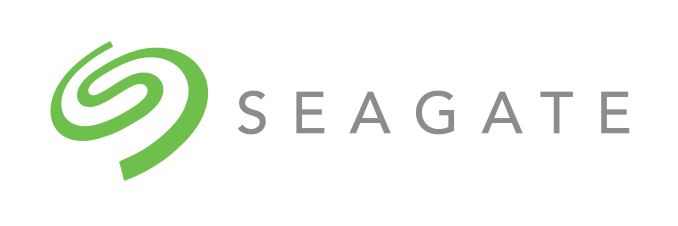
Seagate acquired LaCie a couple of years back. We saw some complementary product lineups last year, but this time around, the integration seems to be well and truly complete. Amongst the new products introduced at CES 2015, the most interesting seemed to be the 7mm thin external USB 3.0 hard drive.
The Seagate Seven is based on a 500 GB 5mm 2.5" Angsana drive (two platters). The SATA-USB 3.0 bridge has been integrated on the main board. A premium steel enclosure creates a unique and striking product at a reasonable $100 price point.
The Seagate Wireless product is an low-cost entry update to the wireless mobile storage lineup for smartphones and tablets. The USB 3.0-based Seagate Wireless Plus and the LaCie Fuel will continue to exist. The new product is USB 2.0-based and has only one available capacity point - 500 GB. It is priced at $129. Unlike the My Passport Wireless that we reviewed late last year, this one doesn't have a SD card slot - the content consumption side is the target market here. Seagate had a handy comparison table in their briefing.
The Seagate Personal Cloud is a NAS lineup targeted towards the average home consumer. It comes in 1 and 2-bay varieties. The mobile apps are the focus here - primary target market being owners with media libraries that need to be streamed to a variety of devices. Seagate operates relay servers with end-to-end encryption so that access to the content on the device is available from anywhere in the world. The various models and price points, as well as the competitive positioning are reproduced below.
On the LaCie side of things, we had the usual fashion statement in the LaCie Mirror - an external 1TB 2.5" USB 3.0 drive that can double up as a mirror. It carries a premium, as usual, with the pricing set at $280. The more exciting product from a technical viewpoint was the LaCie Rugged RAID. The industrial design is almost the same as the LaCie Rugged Thunderbolt that we had reviewed last year. The thickness is more to accommodate two 2.5" drives, and there is a switch to move between RAID 0 and RAID 1 for the internal volume. The device comes with two hard drives. A dual SSD option was ruled out since Thunderbolt and USB 3.0 don't support more than 10 W over the bus.
The pricing of the 4TB version (2x 2TB drives inside) will be $450. Advertised performance numbers include speeds of over 240 MBps in RAID 0. Similar to the Rugged Thunderbolt, the unit is shock, dust and splash-proof, and carries an IP54 rating.
On the enterprise side of things, we finally got a look at the Seagate Kinetic Ethernet-Attached Hard Drive. As a quick introduction, the unit does away with the need for a separate NAS server by presenting two Ethernet links over what looks like a SATA connector. Object-based storage removes lots of overhead. Seagate indicated a growing number of chassis vendors with support for these drives. We hope to do a more detailed investigation into Kinetic in the near future.
Seagate also had a demonstration of a ClusterStor unit from their Xyratex acquisition. Kristian will be covering updates from the SandForce division later this week.


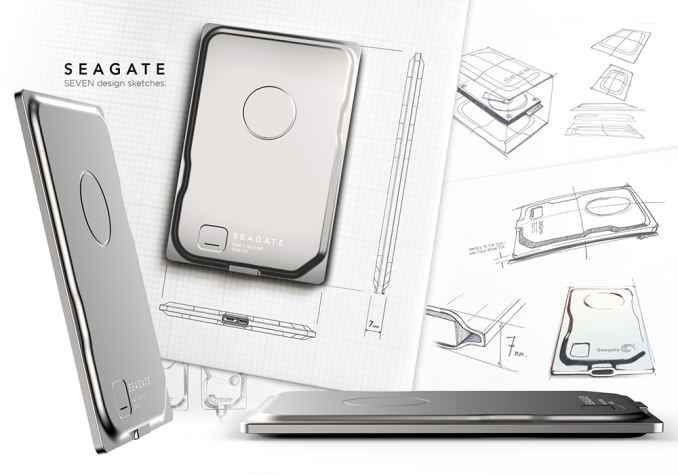
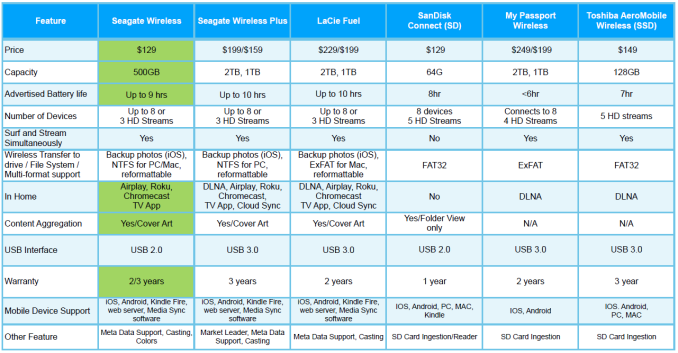
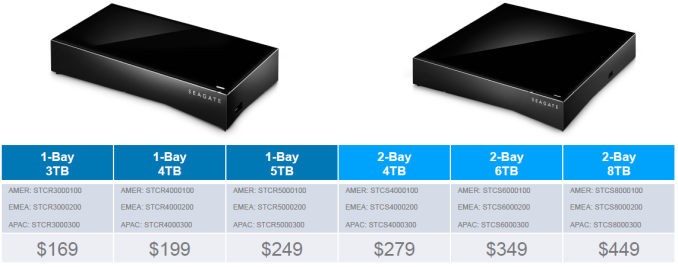

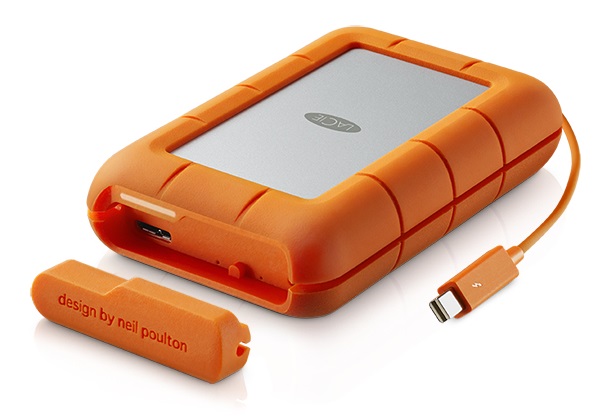
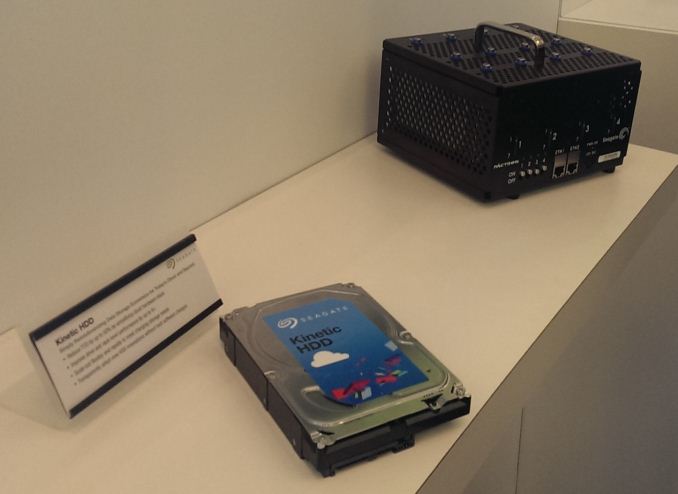








9 Comments
View All Comments
Kevin G - Wednesday, January 7, 2015 - link
" A dual SSD option was ruled out since Thunderbolt and USB 3.0 don't support more than 10 W over the bus."Umm... that's more than enough for two SSD's. The wave of SSD reviews here in late 2014 typically had power consumption per SSD below 4.5W. (That does only leave a meager 1 W for the bridge chip.)
Samus - Wednesday, January 7, 2015 - link
Yeah, that's a pretty BS excuse. They could underclock the controllers if they needed more power envelope headroom...it isn't like USB 3.0 and even Thunderbolt is going to saturate TWO 8-channel NAND controllers with a native (non-SATA) interface so the controllers don't have to be super fast.diddlydoo - Wednesday, January 7, 2015 - link
Anandtech should review Wuala (owned by LaCie/Seagate) and other business grade cloud storage packages for small businesses. Ease of use + security + privacy are most important issuesname99 - Wednesday, January 7, 2015 - link
The Seagate stuff has all been reported before, and is nothing new.Don't they have any of the SMR drives available?
THAT is what we all want to see --- just how well does SMR work in practice in terms of performance, heat, even noise. Is the experience smooth and basically fast (just a slight slow down when you have lots of small writes) or is the drive a grinding high temperature monstrosity?
Samus - Wednesday, January 7, 2015 - link
From what has been reported on the technology, sequential reads are on par with perpendicular recording, sequential writes are about half the speed of perpendicular recording, and random reads/writes are just terrible. It isn't something NCQ can fix, either since this is a physical limitation that can't be fixed by head efficiency.Fittingly, these drives are targeted at cold storage and archiving. They should never be used as a boot\application drive.
name99 - Wednesday, January 7, 2015 - link
Of course ("these drives are targeted at cold storage and archiving").The question is --- if I want to use this drive as, eg, a Time Machine drive, how does it behave in practice. Obviously this is, in some sense, the target market for this type of device. Just as obviously, this is an application that will involve a fair number of small writes along with the large streaming writes.
Hence my questions about things like heat and sound.
We all understand that tradeoffs were made; the question is to try to put some quantifiable flesh on those tradeoffs.
MrSpadge - Wednesday, January 7, 2015 - link
"Amongst the new products introduced at CES 2015, the most interesting seemed to be the 7mm thin external USB 3.0 hard drive."Really? 500 GB for the same price that you normally get 2 TB for, just to save 5 mm height? (the Dell 784-BBBD is 12 mm high) I call this gimmicky rather than interesting. BTW: at 500 GB it surely uses 1 platter, not 2. This density has been around for a few years by now.
name99 - Wednesday, January 7, 2015 - link
Repeat 1000 times: "I am not the world and the world is not me". You may not be in the market for an ultra-thin drive; that doesn't mean the market doesn't exist.I personally am not in the market for an 18 core Xeon, or a Ferrari, or a pair of Louboutin shoes, but I don't pretend those markets therefore don't exist.
Among other things, the value of these physically small drives lies in the fact that the USB stick market is so broken that it's crazy risky buying a large capacity USB stick. Yeah, in theory, you might get one that writes at a tolerable speed, but the betting man would guess that you'd get one with the same pathetic 6MB/s write speed that flash drives had five years ago.
The external thin SSD market is not much better off. I bought one of those OCZ Enyo's a few years ago and this PoS writes at maybe 20MB/s and draws so much power that it can randomly overdraw the USB3 power budget when writing aggressively and so disconnect. But I haven't seen anything taking its place that's much better in terms of performance and reliability.
Until the thumb drive market (one way or another) provides some sort of trustworthy certification of performance, those devices are basically useless for sizes larger than maybe 16GB unless you are REALLY patient. Which means that an alternative which one can be pretty damn sure will NOT run at ridiculously low speeds, and which WILL work (reliably!) even when connected to USB2 (with USB2's power limits) is valuable.
alexvoda - Thursday, January 8, 2015 - link
I am rather disappointed by Seagate because they abandoned the USM standard.I have several USM drives and it is wonderful that I can connect them to the fastest interconnect available on any computer.